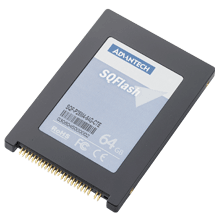 I’m building a new desktop PC for home use, and, now that I’ve gotten used to the amazing boot speeds of my SSD-equipped laptop, I want that technology for my personal PC, as well. But, no more than I’ll actually be using it, I’m having a hard time justifying the cost of both an SSD from which to boot the system and an HDD large enough for to store the video files I plan to collect. It turns out that the optimum solution may be a solid-state hybrid hard drive, or SSHD, a format that marries the economy and capacity of spinning disks with the speed of solid-state media, typically NAND flash. To find out more, I ended up consulting the resource I find myself relying on more each day, Advantech’s growing list of technical white papers.
I’m building a new desktop PC for home use, and, now that I’ve gotten used to the amazing boot speeds of my SSD-equipped laptop, I want that technology for my personal PC, as well. But, no more than I’ll actually be using it, I’m having a hard time justifying the cost of both an SSD from which to boot the system and an HDD large enough for to store the video files I plan to collect. It turns out that the optimum solution may be a solid-state hybrid hard drive, or SSHD, a format that marries the economy and capacity of spinning disks with the speed of solid-state media, typically NAND flash. To find out more, I ended up consulting the resource I find myself relying on more each day, Advantech’s growing list of technical white papers.
In this case, the appropriately titled, Solid State Hybrid Hard Drives, provided the crash course I needed to compare alternatives. SSHDs incorporate control chips that monitor frequency of data access to better assign data to the optimal location, the flash memory or the disk. SSHD typically emulate enterprise-style Hierarchical Storage, scaled to the single hybrid drive, designating the flash segment as first-level storage and assigning second-level status to the disk platters.
5400-RPM HDDs earned an overall SYSMark score of 270, 7200-RPM HDDS scored 286, desktop SSHDs scored 295 and Intel 320 SSD scored 302 on that scale. (SYSMark is a performance testing standard created by Business Applications Performance Corporation, a non-profit consortium of OEMs established to develop objective performance benchmarks for PCs and PC components. SYSMark is designed to ensure oranges-to-oranges comparisons.)
SSHDs performed impressively in SYSMark, but the numbers are far more dramatic in terms of raw boot speed, where the 5400-RPM 1-TB HDD scored a boot time of 6.77 seconds, the 7200-RPM 1-TB HDD scored 6.54 seconds, and a Seagate Desktop SSHD scored 0.5 seconds, equaling the boot time of the Intel 320 SSD. My stated goal was fast boot times, and the Seagate SSHD delivers.
SSHDs are relatively new to the PC market, having been first announced by Intel in October, 2005, but the technology is maturing quickly. Advantech offers the option of ordering a number of its automation systems with Seagate SSHDs factory installed, and I’m a strong believer that the more options you have, the better.
Seagate’s Adaptive Memory technology ensures that the most frequently used data is identified and stored on the NAND flash to optimize overall performance, as well as boot speeds, and its desktop SSHDs are available in 1-TB, 2-TB and 4-TB configurations. Given that I’ll be using my new home PC to store and play lots of video files, the 4-TB option, capable of storing up to 4000 hours of digital video, is the ideal solution to both the boot speed I’ve come to expect and the large storage capacity I require.













